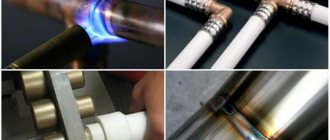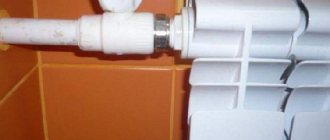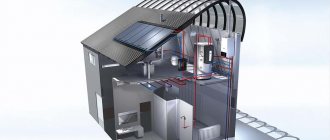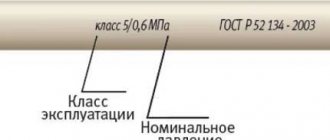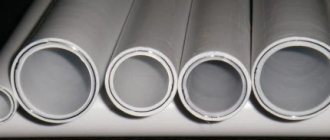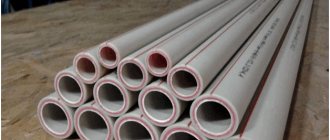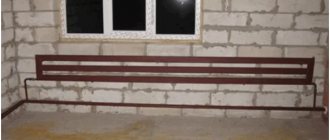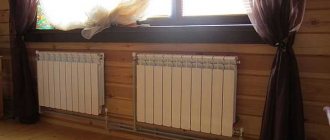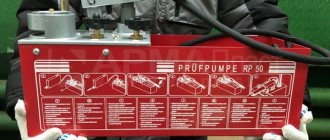- home
- Construction and renovation
- Plumbing
>
>
⬎
There is nothing complicated in the process of welding PPR pipes, which is why this technology has become widespread. Any home craftsman can perform a minimum set of equipment and tools, as well as a little knowledge and plumbing soldering.
However, many beginners and even “masters” often violate the technology of connecting polypropylene pipes, although by and large there is no room for error. Therefore, I suggest that you familiarize yourself with basic information and simple tips.
Stage two. Welding of polypropylene pipes
Welding polypropylene pipes
This procedure will require an electric jigsaw (cutting polypropylene) and special welding equipment.
Welding machine
Step one. While the apparatus is warming up, the necessary measurements are taken, the pipes are marked and cut.
Scissors for cutting polypropylene pipes
Step two. The ends of the products that are planned to be connected to each other are thoroughly cleaned and degreased.
Step three. Using a pencil, mark the depth of insertion of each product into the sleeve. It is typical that at least a millimeter gap should remain, so the pipes do not rest against the fitting coupling.
Errors when butt welding polypropylene pipes
Step four. The PP pipe with fitting is put on the sleeve in accordance with the marks made, and heating of all elements must occur simultaneously.
The heating duration depends not only on the diameter of the products, but also on the depth of welding (this can be found in the table below).
Technological pause table
Step five. After a certain period of time, the products are removed and connected, pressing onto each other with little effort. It is prohibited to rotate the elements along the center line.
Welding process of polypropylene pipes
Step six. Within a few seconds after the connection, an initial adjustment is made, then the elements are finally fixed.
Welding of polypropylene pipesWelding of polypropylene pipes
If there are no gaps left at the connection point, then it (the connection) can be considered high quality.
Manufacturing of welding machine
Due to the fact that a more or less good welding machine costs over a thousand rubles, it is cheaper to rent it or make it yourself. If the latter was chosen, then for work you should prepare:
- thermal paste for computers;
- old model iron;
- bolt, washer for it;
- electric drill;
- sleeve (nozzle) of the required diameter.
The sequence of actions should be as follows.
Step one. In order to improve heat transfer, the sole of the iron is treated with thermal paste, then a Teflon sleeve is fixed. The location of the latter is determined in advance - the wide part up or down.
Step two. The sharp “nose” is filed off for more convenient work near walls.
Step three. The iron is heated until the device turns off a second time.
Step four. It’s good if the iron is equipped with a temperature sensor - this will allow you to accurately determine the heating temperature. But there is an easier way - through lead. This metal melts at 230ᵒC and above, which approximately coincides with the temperature required for welding.
Further soldering technology is identical to that described above.
Basic Soldering Technologies
In order to join the joints of pipes, fittings and auxiliary components, the following soldering techniques are used:
- Diffusion. With this technology, the connection occurs due to heating and compression of the joints, the component bodies do not melt and auxiliary chemicals are not required;
- Electrofitting. This method is based on melting some part of the component using an electric current;
- Cold. Pipeline parts are assembled using an auxiliary reagent, which is solder.
Alternative to welding
In some cases, for example, in hard-to-reach places in the bathroom or other rooms, it is not possible to carry out welding work. The soldering process can be replaced by gluing the pipe to the fitting using an organic solvent. It has a very strong softening effect, but is also highly volatile.
After lubricating the end of the pipe and the internal cavity of the coupling, the plastic softens for a short period of time, and the connection can be made. Reverse polymerization begins after a few seconds.
However, this method is more suitable for PVC pipes that are less prone to thermoplasticity.
If for some reason this option is not suitable, for pipes NOT UNDER PRESSURE it is permissible to use a supercharged lighter instead of a soldering iron. This connection method is shown in the video tutorial below.
It is important to understand: uniform soldering cannot be achieved precisely because of the alternating heating of parts, therefore the technology cannot be used for critical connections
Benefits of using pipe cutters
Pipe cutting scissors can be sold under the names
- Pipe cutters;
- Plumbing cutters.
This tool is designed for rapid cutting of plastic pipeline elements. He cuts them so that no burrs remain at the cut site.
Thus, there is no need for additional processing of cut edges.
Welding temperature of polypropylene pipes
Each soldering iron has a temperature regulator for heating the thermoelements, which sets the temperature for welding polypropylene pipes. The temperature of the soldering iron is set according to the instructions (~300 degrees). The heating time of the pipes depends on their diameter, which is also written in the instructions. For example, pipes with a diameter of 20 mm heat up for 6...7 seconds.
So, set the desired temperature before turning on the device:
If we work in a cold room or outdoors in cold weather (at temperatures below +5 degrees), then the time for soldering polypropylene pipes increases due to the rapid cooling of the soldering iron. The same thing happens in the wind. Therefore, you need to either refuse to work in cold conditions or increase the welding temperature. At the same time, before starting work, test the quality of welding on unnecessary pipe scraps.
Security measures
When working with a heating device, it is necessary to observe personal protective measures:
- The soldering iron must be installed on a horizontal surface in a place free from materials.
- The technician must wear protective gloves (for working with hot tools) and comfortable overalls.
- Avoid bending over melting plastic as this process releases harmful fumes.
- The room should be relatively clean. The working surface is free from dust and debris.
- The connection between the soldering iron plug and the network must be tight and the cord must be loose.
We recommend that you read: How to correctly bend a polypropylene pipe at home and avoid deformation
The welding tool is preheated for 20 minutes if it does not have a corresponding indicator.
Four classes of polypropylene pipes
When changing or installing a water supply or heating system with your own hands, you should purchase PP that will withstand the temperature and pressure of the water.
- For cold water supply, products marked PN 10 are used.
- They withstand high temperatures and are used for hot water supply, heating and sewerage systems with pipes marked PN 20.
- PP marked PN 25 are intended for heating systems.
The shell of pipes marked PN 20 and PN 25 is made of foil or fiberglass. Due to this, the product can withstand hot temperatures without being deformed.
- The surface of the PP should not have any defects.
- Pipe cuts must be smooth and clean, with a smooth surface.
About leaks, fistulas and other reviews about polypropylene
On professional construction forums, many horror stories are told about polypropylene leaks. The climax is a video where a man breaks pipes on a comb like dry rods. Any novice plumber or home craftsman will immediately disown this technology. What can I say, experienced craftsmen are confused by such arguments.
The reason for such defects, oddly enough, is savings on pipes and components. Currently, many products are sold from “basement” factories, for which technical descriptions cannot be found
Please note: if you decide to use a PP-ALUX pipe, for example, from a little-known manufacturer, the data in the pressure and temperature table above does not necessarily apply to your brand. Nobody exempts you from studying technical documentation from a specific pipe manufacturer
It follows from this that many “plumbers” do not bother studying the characteristics of pipes. And this can lead to errors in soldering and installation. By the way, despite the simplicity of the technology, it must be performed with due care, observing the soldering temperature and other nuances. I have seen a lot of pipes soldered by “shabashniks” - in the vast majority of cases, the soldering was done with overheating, the pipe was incorrectly selected for a specific task.
I had to dismantle a lot of plastic pipes and I didn’t come across the horror stories described on the Internet. The pipes, after 5-10 years of operation, were in excellent condition; no cracks or destruction of the material were observed from the inside. Most often, the places where the leak occurred were poorly soldered connections, despite the fact that a properly soldered connection is much more reliable than the pipe itself. In simple terms, it’s hard for me to imagine such “hand-assed” installers. Nevertheless, there are a lot of such installers - they showed the technology, and simply said - this is the end of the worker’s qualifications. Hence all the ensuing consequences and problems, as well as the tarnished reputation of polypropylene.
This piece of pipe is cut from the hot water supply system of an apartment building. According to the customer, the pipes stood for about ten years, the date of manufacture indirectly confirms this. There were no problems, the alteration was carried out to install meters. The cut shows no changes in the thickness of the polypropylene; there is a coffee-colored coating on the inner walls, which can be easily wiped off with a finger. The pipe from Ecoplastic is Czech polypropylene without reinforcement.
Also, polypropylene owes its tarnished reputation to marketers who are actively promoting cross-linked polyethylene
. By the way, cross-linked polyethylene is not as resistant to high temperatures as it seems from beautiful stories. The job of marketers is to emphasize the advantages and gloss over the shortcomings of their product, and comment on the opposite about the competitor’s product. Everything is simple, just study the technical documentation for both products and everything will fall into place.
We will look at soldering polypropylene separately, but that’s all for now. And once again, I strongly recommend that you carefully select all materials for rough plumbing, beware of fakes and approach the issue thoroughly.
Rate this publication:
- Currently 3.78
Rating: 3.8 (37 votes)
Features of the use of fittings
Fittings are small connecting pieces that fit onto the ends of pipes to be soldered. The main types of fittings are
- Crosspieces;
- Water outlets;
- Futorki;
- Sgony;
- Bends.
A home craftsman who is interested in how to solder plastic pipes for heating must take into account the fact that the fittings must be made from exactly the same raw materials as the elements of the communal infrastructure they connect.
Polypropylene taps
When using plastic pipes, it will be more aesthetically pleasing to use taps coated with polypropylene. This is usually what inexperienced plumbers think about. In fact, it is better to use regular brass taps with a transition to polypropylene through a coupling.
At first glance, a faucet filled with a polypropylene shell seems to be the ideal solution. Does not spoil the overall appearance of the plastic pipeline, does not require additional parts for connection to a common unit.
The fact is that taps filled with plastic have lower reliability. The faucet consists of two fundamentally different materials (metal and plastic), with different densities and thermal expansions. Due to different properties, problems often arise in the form of leaks or breakdowns. Global manufacturers recognize the shortcomings of polypropylene cranes and are working on the mistakes, but it is too early to say with complete confidence about reliable cranes of this type.
A much more reliable solution would be a brass tap with two threaded couplings. The coupling also contains two materials, metal and plastic, but these parts are stationary, unlike a tap.
In addition to reliability, there is also an aesthetic side to using conventional taps: the tap can be rotated along its axis and given a more even position. The sealed plastic tap cannot be turned on the pipe; you need to do the soldering very clearly the first time; the soldering can only be corrected by soldering in a new tap.
In fact, brass faucets provide more options. They can be replaced without soldering, if the faucet comes with an American one; the connection is detachable in case of other repairs. American becomes relevant when installed in hard-to-reach places.
In addition, conventional cranes are, as a rule, smaller in size, and the range of products is much wider.
Just like brass, polypropylene taps come in two types: valve and ball
Please note that ball valves can only be used in two positions: open and closed, adjustment is not allowed. All manufacturers say so
However, on this score, in the process of working as a plumber, a different opinion was formed...
The above is true for expensive, high-quality products, but in our realities, as a rule, we have to deal with budget faucets. So, if we compare two budget products, a valve and a ball valve, the ball wins in terms of reliability, even with constant adjustment. Although the valve is specifically designed for regulation, it fails very quickly. This opinion has been formed over many years of work. These considerations are valid both for brass shut-off and control valves, and for products filled with polypropylene.
And finally, I would like to say: you should not skimp on taps, as well as on all plumbing fixtures. Pipes and all components should be purchased from reliable stores; this should be done slowly and thoughtfully!
Common mistakes
Soldering plastic pipes does not require special skills, but if you do not adhere to established norms and rules, you can still ruin the connection. Typical mistakes of novice masters are:
- using dirty attachments. If drops of molten polymer remain on the nozzles, then during the next welding they can wedge between the edges of the products and sharply weaken the connecting seam;
- residual water and dirt on the outer surface. They will prevent close contact of the surfaces of parts over the entire area;
- applying excessive force when combining parts. Part of the melt under excess pressure can be squeezed into the pipe and reduce its permeability;
- an attempt to clean up the sagging of molten plastic before the joint has completely cooled, which inevitably leads to deformation of the pipe;
- insufficient heating or overheating of the joint.
Advantages of polypropylene pipes
- High thermal insulation performance. You can verify the correctness of this statement even without the presence of special devices - simply compare the surfaces of polypropylene and metal pipes by touch. Polypropylene walls will be barely warm, and metal ones, all other things being equal, can even leave a burn. This confirms that the metal is losing thermal energy.
- High resistance to chemical and corrosive influences. This helps to significantly increase the service life of polypropylene pipes.
- High technology. Polypropylene pipes are easy to cut and weld. To connect elements, it is enough to have a soldering iron specially designed for this purpose and additional connecting elements. At the same time, you can handle all the work on wiring and connecting elements of the heating system yourself.
- Good elasticity indicators. This property of polypropylene makes the material resistant to system freezing, which quite often occurs in private households.
Classification by heat resistance
Based on the melting point of a particular solder, it is classified into the following subclasses:
- Low temperature;
- Medium melting;
- Refractory.
Types and purpose
Polypropylene pipes can be of four colors - green, gray, white and black. Only black ones differ in their characteristics - they have increased resistance to ultraviolet radiation and are used when laying an irrigation system on the ground. All others have similar characteristics and are laid indoors or buried in the ground.
According to their intended purpose, polypropylene pipes are of the following types:
- For cold water (temperature up to +45°C). They can be easily distinguished by their longitudinal blue stripe.
- For hot water supply (heating up to +85°C). A distinctive feature is a red stripe.
- Universal (maximum heating up to +65-75°C depending on the manufacturer). Two stripes are applied side by side - blue and red.
There are pipes with different characteristics for both cold and hot water. This is displayed in the markings:
- PN10 are used exclusively in cold water supply systems (up to +45°C) with low pressure (up to 1 MPa). They have small wall thickness. Not suitable for high-rise buildings.
- PN16. They are often labeled as universal, but are more often used for cold water - they can withstand heating of the environment up to +65°C and pressure up to 1.6 MPa.
- PN20. Thick-walled pipes, which can transport media with temperatures up to +80°C, can withstand pressures of up to 2 MPa. Used for distributing hot water and heating systems.
- PN25. These are reinforced polypropylene pipes (with foil or fiberglass). Due to the presence of a reinforcing layer, they often have a smaller wall thickness than PN20. The heating temperature of the medium is up to +95°C, pressure is up to 2.5 MPa. Used for hot water supply and heating.
All of them are produced in different diameters - up to 600 mm, but in apartments and private houses they are used mainly in sizes from 16 mm to 110 mm
Please note that the internal diameter is indicated, as wall thickness may vary.
https://youtube.com/watch?v=fKf2kG7gHvw
Preparation for installation of PP pipes
It is impossible to do plumbing with hands and pipes alone, so you should understand the heating and water supply schemes, the necessary tools, connection methods and materials used.
The assembly of a water supply system from PP pipes includes a number of traditional steps:
Stage #1. Drafting
Before purchasing material for installing heating and plumbing, you need to decide on their wiring diagram.
There are four main ways to connect batteries to the heating circuit:
- flow-through;
- with unregulated bypass;
- with valves;
- with three-way valve.
The final choice of installation option is usually determined by the financial capabilities of the apartment owners, because shut-off valves are not cheap.
Schemes with adjustable valves allow you to regulate the power of radiators separately in each room of the house without compromising the hydrodynamics of the system
The water supply system also has basic design diagrams for wiring, but there are only two of them: collector and tee (traditional in apartments).
The tee circuit is installed in apartments where a short length of pipes and a small number of simultaneously used plumbing fixtures do not lead to a drop in pressure in the general circuit
A tee circuit is also called sequential. It involves running one pipe along all plumbing fixtures, from which branches are made sequentially using a tee.
The collector circuit involves installing a flute-shaped collector at the water inlet to the house. It allows you to compactly make several bends in different directions.
The collector circuit is recommended for installation in large houses, where a drop in main pressure is possible when several plumbing fixtures are turned on simultaneously
The wiring can be done inside the walls or in the open. The first option requires detailed calculations that take into account the elongation of pipes when heated.
We advise you to familiarize yourself in more detail with the wiring diagrams for water supply pipes made from PP pipes.
Stage #2. Preparing tools
A significant disadvantage of working independently with polypropylene pipes is the need to use special tools. The price of an installation equipment kit ranges from 100 to 200 dollars.
The contents of ready-made kits may differ from one manufacturer to another. The overall price is especially affected by the power of the soldering iron and its functionality.
This set should include:
- an electric welding machine with a stand or simply a soldering iron for PP pipes;
- pipe cutters;
- shaver for removing the outer layer and aluminum from reinforced pipes;
- calibrator and chamfer for monitoring and adjusting the diameter of parts;
- nozzles for heating the elements being soldered.
In addition to special equipment, to install PP pipes you will need an adjustable wrench, a marker, a tape measure and other general household tools.
If you are planning one-time installation work, you can rent a soldering kit.
Stage #3. Selection of polypropylene fittings
PP fittings are used to weld PP pipes together in various combinations, as well as to connect them to plumbing fixtures.
These include;
- adapters;
- nipple bends;
- couplings;
- threaded couplings;
- tees;
- plugs;
- crosses;
- detachable connectors;
- Ball Valves;
- clamps.
Some tips for choosing fittings and installing pipes:
The quality of polypropylene and the wall thickness of fittings may also differ, so you need to choose them according to the marking of the pipes.
Stage #4. Selecting a connection diagram
There is a fundamental difference in soldering pipes with a diameter of up to 63 mm and from 63 mm. Pipes that are equal to or larger than this size are butt soldered, and those that are smaller are connected using the socket method.
The latter involves the formation of a joint due to the fact that the molten cut end of the pipe enters a few centimeters into the expanded socket of the fitting.
The same method is used to connect two pipes to each other using a coupling.
When connecting pipes in opposite directions, it is important that no protruding inward bulge is formed at their junction: it will impede the movement of water, lowering the pressure in the system
Depending on the presence of threaded parts, connections of PP products can be:
- detachable;
- one-piece.
Detachable connections involve soldering two threaded fittings with external and internal threads to the ends of the connecting parts.
The one-piece type includes the above-described socket connection method by soldering two polypropylene products.
To learn more about the technology of welding polypropylene pipes, follow this link.
Expert advice
To ensure maximum reliability of pipeline connections, experts advise adhering to the following requirements:
- it is correct to start welding work 10 minutes from the moment the soldering iron warms up;
- perform welding or soldering operations only at above-zero ambient temperatures;
- sections of pipes connected by welding must be allowed to cool, preventing them from moving relative to each other or twisting;
- For wall thicknesses greater than 6 mm, butt welding of products is performed using a double seam. With a smaller wall thickness, the joint can be sealed with one seam;
- all structural elements fixed by soldering must be from the same manufacturer, since they may differ in the composition of the ingredients in the raw materials, which will negatively affect the quality of the weld.
Soldering in hard-to-reach places and corners
When soldering pipes located in hard-to-reach places, for example, close to the surface of walls or ceilings, a special technique is used, which consists of sequential heating of the direct and counter sections of the connection with a soldering apparatus. It is necessary to warm up the flange of the straight section for a longer period of time so that it does not have time to cool down while the counter part of the workpiece is in operation.
A smooth line at corner joints of pipes can be achieved by using special corner adapters and fittings. In this case, it is important to very accurately mark in advance on the supply pipes the depth of their entry into the body of the corner piece.
Connecting plastic pipes without soldering
Plastic pipes do not have to be welded; they can be joined using a special adhesive. It is applied to the entire pre-degreased surface of the pipe section that will be inserted into the socket. In the bell, the inner surface is also degreased and covered with glue, but only 2/3. For better adhesion, the surfaces of the pipes under the adhesive joint are treated with sandpaper before degreasing.
The prepared part of the pipe is inserted into the socket until it stops and rotated 90 degrees. In this position, the parts to be glued should be held for 1 - 1.5 minutes until the glue sets.
The adhesive will dry completely within a few hours.
Plastic sewer pipes leading to the Tank septic tank can be connected using a compression fitting. With this method, the process of connecting pipes consists of the following steps:
- cleaning the top layer of the pipe from contaminants;
- chamfering at the end;
- loosening the union nut on the fitting and installing the end of the pipe into it;
- tightening the nut in the reverse position, at this moment the pipe is clamped (compressed) by the ferrule ring.
Fittings are fixed manually or using an open-end wrench. The applied force should not be excessive, otherwise the pipes may burst.
The socket method involves the use of a highly elastic sealing ring. The tightness of the connection is ensured by compression of the gasket between the walls of the socket and the smooth end of the pipe.
Welding large diameter plastic pipes
To connect pipes with a diameter of more than 50 mm and a wall thickness of 4 mm, butt soldering technology is used, which consists of simultaneous welding of the ends of 2 segments along the entire plane. The most difficult thing in this welding method is to correctly align the joints and ensure the required length of the gap between the parts.
Therefore, in the process of butt welding of large diameter pipes, guides or a pipe centralizer are used. It will provide high-quality and reliable fixation of sections for welding.
The work itself is carried out in the following order:
- pipe preparation and edge cleaning;
- securing elements in a pipe centralizer;
- welding of joints of products.
Pipeline installation
Installation of a heating pipeline in a private house involves connecting individual elements into a single system. Perform the following operations:
- layout of elements according to the diagram;
- welding or soldering of pipes;
- connection using fittings;
- connection of heating devices.
Since plastic materials expand when heated, expansion joints are installed. This is a loop of pipe that is soldered into the pipeline on long straight sections. After completion of installation work, it is necessary to carry out a test under operating pressure.
How to solder a heating pipeline
We will describe below how to properly solder heating from propylene pipes. When polypropylene is heated to +260 degrees, it melts, which makes it possible to connect individual elements. This is ensured by the phenomenon of polyfusion - the interpenetration of atoms. We get the junction of two parts that are not separated by a border.
The soldering iron is selected depending on the type of soldering - butt, coupling or fitting. It has nozzles onto which sections of pipes to be connected or a pipe and fitting are put on. After heating, they are tightly connected and held for 4-6 seconds. The heating and cooling time of the connected polypropylene elements depends on their diameter. The data is given in the table, which can be found in the specialized literature.
Attaching the pipeline to the wall
The pipeline is secured to the wall using clips and clamps. Clips ensure that the pipe remains stationary along its axis.
They are attached to the wall with a clamp, placing the pipes no closer than 20 mm from it. Fasteners are placed at a distance of no more than one and a half meters from each other. In places where pipes turn or branch, additional fasteners are installed.
Radiator mounting
Radiators are hung on metal brackets included in the delivery kit and secured to the wall with dowels. Their thickness depends on the weight of the battery. Cast iron elements are additionally supported by legs.
Heating schemes made of polypropylene for a private house
- single-pipe or double-pipe;
- two-pipe with horizontal wiring;
- two-pipe with vertical wiring;
- collector
The single-pipe scheme provides for the passage of liquid in one direction. It is used when connecting radiators in series. The two-pipe model has a return line.
Two-pipe circuit with horizontal wiring
In this scheme, polypropylene pipes are located along the wall just above the floor level, which makes them inconspicuous and does not disturb the aesthetics of the room. This is a conventional two-pipe system with bottom wiring. Most often, heating radiators are installed around the perimeter of the room.
Vertical wiring diagram
The vertical layout is used for heating manor houses with 2 floors or more. The heated liquid is transported between floors via risers. The layout can be upper or lower in relation to the radiator. The upper model is more often used with natural circulation. On each floor you can make a horizontal heat distribution scheme. In this case, one riser is installed, through which the coolant will be transferred to each floor.
Using the distribution manifold
In a heating model with forced circulation, a collector is often installed. In it, a comb of pipes extends from the main riser; their number is equal to the number of heat consumers. Each polypropylene pipe has a separate valve that turns off a specific line. This system allows you to distribute heat evenly and, if necessary, reduce the temperature in a private home.
The disadvantage is the high cost of installation, as the length of the pipeline and the number of fittings increases. However, it is convenient to operate; it is possible to separately turn off the damaged area. Complex collectors are equipped with automatic devices that regulate the temperature of the coolant and turn off the system in an emergency.
One of the methods of heating a home is a water heated floor. Polypropylene pipes are widely used for its installation. The water floor heating system is connected to the main heating network.
Organizing the heating of a manor house is a complex process.
To do it yourself, you need to study methods and models of pipe laying, select suitable materials and fittings. It would be a good idea to familiarize yourself with heating projects for residential buildings that are similar in design and size to your home. Date: September 25, 2022

